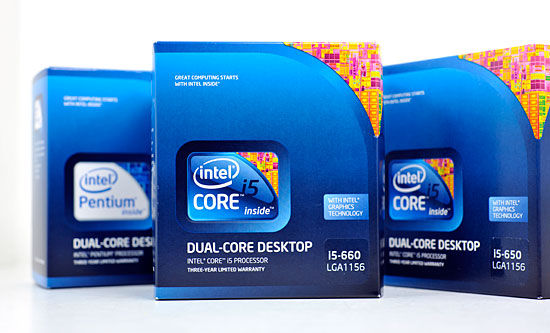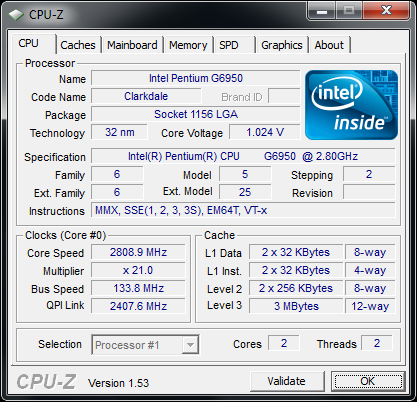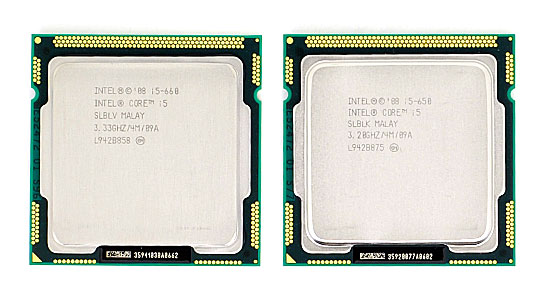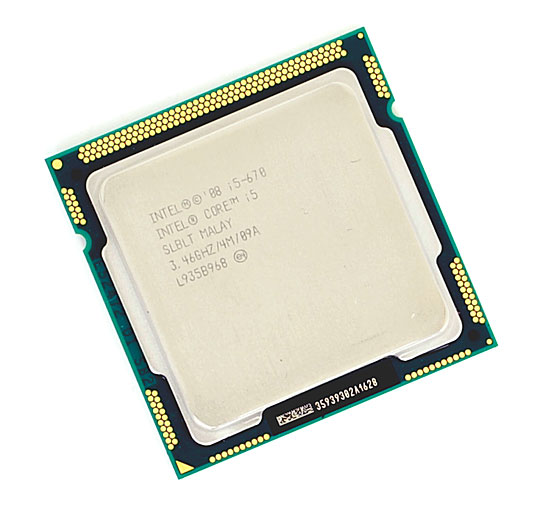The Rest of Clarkdale: Intel's Pentium G6950 & Core i5 650/660/670 Reviewed
by Anand Lal Shimpi on March 24, 2010 4:00 PM EST- Posted in
- CPUs
Two months ago AMD released a bunch of new CPUs priced between $70 - $120. For the past couple of years AMD has been enjoying the fact that Intel's newest architectures start out at the higher price points, and take their sweet time to trickle down to the common man's socket. With Clarkdale, everything changed.

The cheapest Core i3 is the 530, selling for $113 in 1K unit quantities and around $120 on the street (keepin it real). To paraphrase a short, wise, green man - there is another, even cheaper Clarkdale that you can buy though - the Pentium G6950:

This is a LGA-1156 part based on the Clarkdale core, just like the rest of the Core i3 and dual-core Core i5 line. The chip runs at 2.80GHz, has no turbo support, no AES-NI, no VT-d, no Intel TXT and no Hyper Threading.
| Processor | Core | Un-core | GPU | Max Mem Clock | Cores / Threads | L3 Cache | Max Turbo | TDP | Price |
| Intel Core i5-670 | 3.46GHz | 2.40GHz | 733MHz | 1333MHz | 2 / 4 | 4MB | 3.76GHz | 73W | $284 |
| Intel Core i5-661 | 3.33GHz | 2.40GHz | 900MHz | 1333MHz | 2 / 4 | 4MB | 3.60GHz | 87W | $196 |
| Intel Core i5-660 | 3.33GHz | 2.40GHz | 733MHz | 1333MHz | 2 / 4 | 4MB | 3.60GHz | 73W | $196 |
| Intel Core i5-650 | 3.20GHz | 2.40GHz | 733MHz | 1333MHz | 2 / 4 | 4MB | 3.46GHz | 73W | $176 |
| Intel Core i3-540 | 3.06GHz | 2.13GHz | 733MHz | 1333MHz | 2 / 4 | 4MB | N/A | 73W | $133 |
| Intel Core i3-530 | 2.93GHz | 2.13GHz | 733MHz | 1333MHz | 2 / 4 | 4MB | N/A | 73W | $113 |
| Intel Pentium G9650 | 2.80GHz | 2.00GHz | 533MHz | 1066MHz | 2 / 2 | 3MB | N/A | 73W | $87 |
Intel also disables a portion of the L3 cache, there's only 3MB active on the G6950. The on-package memory controller is also limited to only 1066MHz, while the Core i3s and i5s support up to 1333MHz. Finally its on-package GPU only runs at 533MHz. At a high level, the Pentium G6950 doesn't look too good.

Then again, it lists for $87. Newegg sells it for $96.
The Rest of the Story
To date we’ve only looked at the Core i3 530, 540 and Core i5 661. Since we’re tying up loose ends today we’ll also include results from the rest of the Clarkdale lineup: the Core i5 670, 660 and 650.

The Core i5 660 is just like the 661 we reviewed in January but with a 733MHz GPU clock instead of 900MHz. The 650 is the cheapest i5 Intel offers at $176.

The Core i5 670 is the highest native clocked CPU that Intel ships today at 3.46GHz. It's GPU still only runs at 733MHz though, only the 661 has a 900MHz GPU clock. It's also the most expensive dual core i5 Intel makes at $284. You can get a Core i5 750 for less or a Core i7 860 for the same price. This is clearly a chip for a very specific niche market that needs excellent performance out of two cores and integrated graphics.










70 Comments
View All Comments
Teloy - Friday, March 26, 2010 - link
"It's GPU still only runs at 733MHz though"... "It's" is not quite right... Take care.8steve8 - Thursday, March 25, 2010 - link
why was the G45 omitted on pg2 in the graph of power consumption under load with integrated graphics?I was keen to see how much more efficient HD graphics were than g45.
-stephen
bpdski - Thursday, March 25, 2010 - link
It would have been nice to see the benchmarks run with the overclocked G6950 also.- Brian
Taft12 - Thursday, March 25, 2010 - link
I have a hard time comprehending what Intel/AMD's TDP ratings mean in light of the "Load Power Consumption" graph.How is it that Intel CPUs with higher TDP ratings consume MUCH LESS power at load than AMD CPUs with lower TDP ratings. Just looks at the results -- all of the Intel core i3/5 CPUs are 73W TDP but the Athlon X2 255 is rated at 65W yet consumes 20 more watts at load. Is the 790FX motherboard that inefficient? WTF???
Lower idle consumption for Intel I understand due to the smaller process and excellent design, but do the TDP ratings truly mean nothing? This is a disastrous result for AMD.
strikeback03 - Friday, March 26, 2010 - link
Both companies rate their TDP differently, and in either case it is not designed to be a measure of power consumption.Nickel020 - Thursday, March 25, 2010 - link
It would be nice if you could include the 661 in the power consumption charts. Does its higher TDP actually lead to higehr power consumption?Sunburn74 - Thursday, March 25, 2010 - link
If you're gonna talk about the value of a 4.4 ghz overclocked processor, you gotta include it the benchmarks. Duh!crochat - Thursday, March 25, 2010 - link
Why the hell is it necessary to always put discrete graphics card in systems with integrated graphics and do power consumption tests with it? Is the benchmark used for power independent from the graphics card?I understand that it is much simpler to measure watts only, but what is important is the resulting task energy consumption, taking into account the efficiency of the processor..
strikeback03 - Friday, March 26, 2010 - link
Because some of the tested systems don't have integrated graphics. So for the application performance comparisons shown to be valid, the discrete GPU has to be kept in there. Wouldn't want someone thinking they could get 69.1 FPS in Crysis Warhead with the power consumption of only the integrated graphics.Taft12 - Thursday, March 25, 2010 - link
It's necessary to save many hours of work the testers could spend on more articles. What counts is the delta in power consumption between CPUs/platforms at idle and load.I'm an AMD fan, but the bottom line is Intel systems are more power efficient, period.